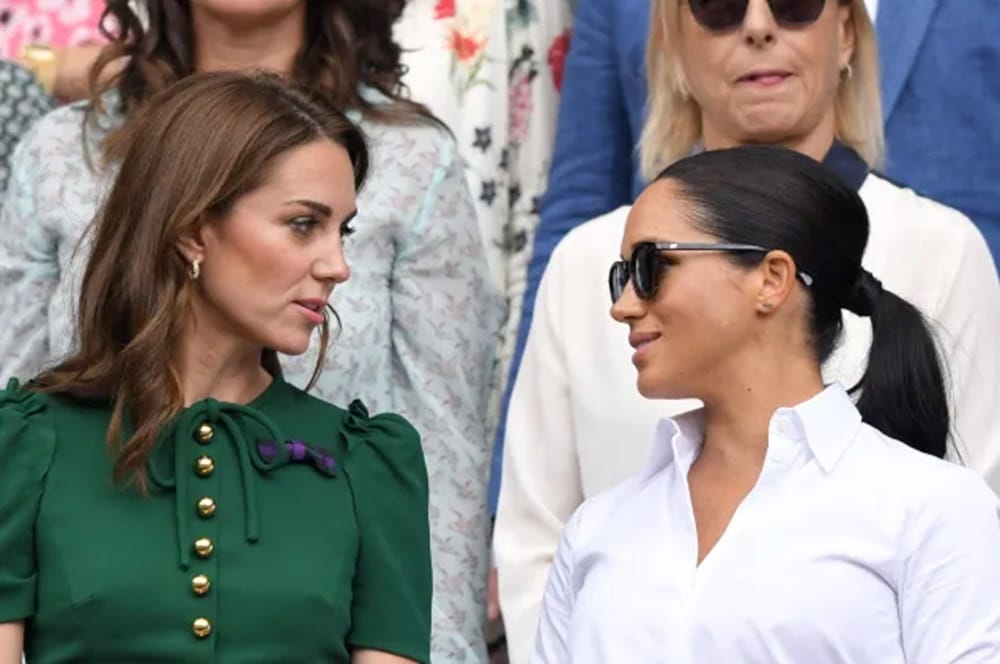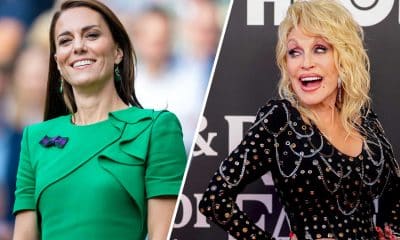Celebrity
Why Brits Adore Kate Middleton and Question Meghan

The British royal family has long been a source of fascination and intrigue for people worldwide. In recent years, the spotlight has shone brightly on two prominent figures: Kate Middleton and Meghan Markle. These two women have captured the public’s attention differently, with Kate often seen as the epitome of traditional grace and charm, while Meghan is viewed as more modern and unconventional.
As we delve into why Brits seem to love Kate Middleton and harbour negative feelings towards Meghan, it’s important to understand the nuances that shape public perception. Kate, the Duchess of Cambridge, has embraced her role within the royal family, exuding a sense of time-honoured elegance that resonates with many Brits. On the other hand, Meghan, the Duchess of Sussex, has been perceived as a more outspoken and independent figure, challenging the traditional norms of the monarchy.
By exploring the reasons behind these contrasting sentiments, we aim to unravel the complexities of public opinion towards the two duchesses. From their backgrounds to their approaches to royal duties, each woman brings a unique perspective to the royal family dynamic. Join us on this journey as we dissect the factors contributing to the love for Kate and the less favourable attitudes toward Meghan within British society.
Royal Family Dynamics
The British royal family holds a unique position in society, blending tradition with modernity in a delicate dance that captivates the public’s attention. The historical significance of the monarchy is undeniable, with its centuries-old traditions shaping public opinion and influencing media coverage. Understanding the dynamics within the royal family is key to comprehending why certain members, like Kate and Meghan, evoke differing reactions from the British public.
Tradition vs. Modernity
The royal family represents a blend of timeless traditions and the pressure to adapt to modern expectations. Kate Middleton embodies traditional values, seamlessly integrating into the royal protocol with grace and sophistication.
In contrast, Meghan Markle brought fresh air to the monarchy, challenging conventions with her modern approach to royal duties. This stark difference in their assimilation into the royal lifestyle sets the stage for contrasting perceptions among the British populace.
Media Portrayal
The media plays a pivotal role in shaping public perception of the royal family members, often crafting narratives that influence how the masses view individuals. Kate’s portrayal in the media has been largely positive, portraying her as a devoted wife and mother who upholds traditional values.
On the other hand, Meghan faced intense scrutiny and negative press, with headlines often focusing on her perceived defiance of royal norms. The impact of media bias on the public’s perception of Kate and Meghan underscores the power dynamics at play within the royal family.
Intriguingly, the interplay between tradition and modernity, coupled with media representation, offers a glimpse into the complexities of the royal family dynamics. As the saga unfolds, the contrasting receptions of Kate and Meghan shed light on the intricacies of royal life in the public eye.
Kate Middleton: The People’s Duchess
Kate Middleton’s British upbringing and relatable persona have played a significant role in endearing her to the British public. Growing up in England, Kate’s roots resonate with many, creating a sense of familiarity and connection with the people. Her down-to-earth nature and approachable demeanour have made her a beloved figure, genuinely and authentically bridging the gap between royalty and the public.
British Roots and Relatability
Kate Middleton’s background as a commoner who transitioned into royalty gives her a unique appeal to the British public. Her relatability stems from her modest beginnings, allowing many to see a bit of themselves in her journey. This relatability creates a sense of closeness and understanding that transcends societal barriers, making Kate feel like a friend rather than an unapproachable figure on a pedestal.
Graceful Conduct and Traditional Values
Known for her poise and elegance, Kate Middleton embodies grace in her conduct as a royal family member. Her adherence to royal protocols and commitment to upholding traditional values have earned her respect and admiration from traditionalists. By embracing the customs and traditions of the monarchy, Kate has demonstrated her dedication to preserving the heritage and legacy of the British royal family, strengthening her bond with those who value tradition and history.
Kate Middleton’s ability to blend her modern sensibilities with a deep respect for royal traditions has positioned her as a modern-day duchess with a timeless charm. Her graceful conduct and traditional values reflect her integrity and serve as a beacon of stability and continuity in a rapidly changing world. By staying true to herself while honouring the legacy of the monarchy, Kate has captured the hearts of the British public and solidified her place as the People’s Duchess.
Meghan Markle: The Controversial Duchess
Meghan Markle’s journey into the royal family brought a touch of American flair and modernization, contrasting with the traditional norms of the British monarchy. Her progressive views and unapologetic approach have often clashed with established royal protocols, creating controversies and stirring mixed reactions across British society.
American Influence and Modernization
Meghan’s American background has injected a fresh perspective into the royal fold, challenging age-old customs and pushing for more inclusive practices. Her advocacy for gender equality, racial justice, and social change has been met with admiration and scepticism. Some segments of British society have struggled to adapt to her outspoken nature, perceiving it as a departure from the reserved demeanour expected of royals.
Media Scrutiny and Tabloid Criticism
Since her relationship with Prince Harry became public, Meghan Markle has been under relentless media scrutiny, with tabloids often portraying her negatively. The press coverage intensified as she transitioned into royal life, amplifying the criticisms and spreading sensationalized stories that fueled public scepticism. The constant barrage of negative narratives has deepened the divide between Meghan and certain factions of the British public, shaping the perceptions surrounding her in the UK.
In the intricate tapestry of royal life, Meghan Markle’s presence has been a source of fascination and friction, embodying a blend of tradition and modernity that continues to captivate and polarize audiences worldwide.
Public Perception and Cultural Factors
The public perception of royals like Kate and Meghan in Britain is intrinsically tied to cultural factors that shape how they are viewed by society. Let’s explore how these factors influence the contrasting attitudes towards the two duchesses.
Class Divide and Social Traditions
In British society, the class system and entrenched social traditions significantly shape public opinion of royals. With her middle-class background and familiar upbringing, Kate often embodies the traditional image of a royal consort that many Brits can relate to.
On the other hand, Meghan, with her mixed-race heritage and American upbringing, challenges the norms and traditions of the royal family, leading to a more polarized view among the public. The divide between Kate and Meghan reflects deeper societal divisions around class, race, and cultural identities, influencing how the British public perceives each duchess.
Gender Roles and Feminist Discourse
The scrutiny faced by Kate and Meghan also extends to gender roles and feminist discourse. Through a traditional, patriarchal lens, Kate is often portrayed as the epitome of grace and duty, adhering to age-old expectations of royal women.
In contrast, Meghan’s assertiveness, independence, and outspoken nature have been met with admiration and criticism, sparking conversations about gender equality and feminism. The differing treatment of Kate and Meghan sheds light on evolving attitudes towards women in the public eye, with Meghan challenging stereotypes and pushing boundaries in ways that resonate with modern audiences.
By delving into the complexities of class distinctions, social traditions, gender roles, and feminist discourse, we can better understand the multifaceted layers of public perception surrounding Kate and Meghan in British society. These cultural influences shape how the two duchesses are perceived and reflect broader societal shifts and ongoing conversations about identity, tradition, and progress.
Future of Royal Popularity
The Royal Family stands at a pivotal juncture in its journey, seeking to adapt to the changing winds of modernity while upholding traditional values that have long defined the monarchy’s identity. As public scrutiny intensifies and expectations evolve, it becomes increasingly crucial for the royals to navigate these challenges with finesse and foresight. Here, we delve into strategies that could shape the future of royal popularity, ensuring relevance and resonance with contemporary audiences.
Adaptation and Unity
In a world marked by diversity and rapid change, the Royal Family must embrace a proactive approach to remain relevant and embraced by the people. The royals can bridge the gap between tradition and modernity by fostering unity within the family and demonstrating inclusivity in their engagements. Embracing societal shifts and cultural diversity can help the royals connect with a broader audience, ensuring that their image resonates with the values of a changing society.
Media Responsibility and Ethical Reporting
The media is pivotal in shaping public opinion about the royals, influencing perceptions and narratives that can make or break reputations. Journalists and media outlets must exercise ethical reporting practices, promoting fairness, balance, and accuracy in their coverage of royal events. By holding the media accountable for portraying royal family members, the narrative can shift towards a more nuanced and respectful depiction, fostering a healthier relationship between the monarchy and the public.
As the Royal Family navigates the complexities of modernity and media scrutiny, embracing adaptation, unity, and responsible reporting can pave the way for a future where their image remains strong and relevant in an ever-changing societal landscape. By staying true to their values while embracing evolution, the royals can ensure that public support endures, securing their relevance for future generations.
Conclusion
In wrapping up, it’s clear that the British public’s adoration of Kate Middleton and their disdain for Meghan Markle stem from a complex interplay of tradition, tabloid scrutiny, and societal expectations. Kate is seen as the epitome of grace and duty, embodying the traditional values that many Brits hold dear. On the other hand, Meghan’s outspoken nature and boundary-pushing ways have ruffled feathers and challenged the status quo, leading to a more polarizing reception.
This stark contrast in public perception not only shapes the royal family’s dynamics but also reflects broader societal norms and attitudes towards women in the public eye. How Kate and Meghan are portrayed and received sheds light on the deeply ingrained biases and expectations placed on women, especially those who dare to challenge conventions. As we dissect the reasons behind the love for Kate and the hate for Meghan, it’s essential to consider the implications for the royal family and society.
By Geff Thomas
Celebrity
Bernice Johnson Reagon, Whose Powerful Voice Helped Propel The Civil Rights Movement, Has Died

Nashville, Tennessee – Bernice Johnson Reagon, a musician and scholar who utilised her rich, powerful contralto voice to support the American Civil Rights Movement and global human rights campaigns, died on July 16, according to her daughter’s social media post. She was 81.
Reagon was best known as the founder of Sweet Honey in the Rock, an internationally recognized African American female cappella group that she managed from 1973 until her retirement in 2004. The Grammy-nominated group’s purpose has been to educate, empower, and entertain. They sing songs from various genres, including spirituals, children’s music, blues, and jazz. Some of their original compositions pay tribute to American civil rights leaders and foreign liberation movements, such as the struggle against apartheid in South Africa.
Bernice Johnson Reagon, Whose Powerful Voice Helped Propel The Civil Rights Movement, Has Died
“She was incredible,” said Tammy Kernodle, a prominent professor of music at Miami University with a focus on African American music. She referred to Reagon as someone “whose divine energy, intellect, and talent all intersect in such a way to initiate change in the atmosphere.”
According to an obituary posted on social media by her daughter, musician Toshi Reagon, Reagon’s musical activism began in the early 1960s when she worked as a field secretary for the Student Nonviolent Coordinating Committee and became an initial member of the Freedom Singers. In 2010, the trio reassembled and was joined by Toshi Reagon to play for then-President Barack Obama in a White House performance series televised nationally on public television.
Reagon was born in 1942 in Dougherty County, Georgia, outside of Albany. In the early 1960s, he attended music workshops at Tennessee’s Highlander Folk School, an activist training ground. At an anniversary celebration in 2007, Reagon explained how the institution helped her recognize her musical history as unique.
“From the time I was born, we were always singing,” Reagon told me. “When you’re in a culture and, quote, ‘doing what comes naturally to you,’ you don’t notice it. I believe my work as a cultural scholar, singer, and composer would have been very different if someone had not drawn my attention to the people who need songs to stay alive, to keep themselves together, or to boost the energy in a movement.”
Reagon was arrested and dismissed from Albany State College after participating in a civil rights march. She eventually graduated from Spellman College. While a graduate student of history at Howard University and the vocal director of the D.C. Black Repertory Company, she founded Sweet Honey in the Rock.
In 1965, Reagon recorded her debut solo album, “Folk Songs: The South,” for Folkways Records. She joined Atlanta’s Harambee Singers as a founding member in 1966.
According to the Smithsonian, Reagon began working with the institution in 1969 when she was asked to organize and manage a 1970 festival program called Black Music Through the Languages of the New World. She went on to curate the African Diaspora Program and establish and lead the Program in Black American Culture at the National Museum of American History, where she ultimately became curator emeritus. She produced and played on many Smithsonian Folkways recordings.
Reagon was a distinguished professor of history at American University in Washington for a decade, commencing in 1993 and ending as a professor emerita.
According to Kernodle, we think that music has always been a component of civil rights activity, but it was people like Reagon who made music “part of the strategy of nonviolent resistance.” They brought those songs and practices from within the church to the streets and jail cells. And they popularised such songs.”
Bernice Johnson Reagon, Whose Powerful Voice Helped Propel The Civil Rights Movement, Has Died
“What she also did that was very important was that she historicised how that music functioned in the civil rights movement,” according to Kernodle. “Her dissertation was one of the first real studies of civil rights music.”
Reagon won two George F. Peabody Awards, including one for her role as lead scholar, conceptual producer, and host of the Smithsonian Institution and National Public Radio series “Wade in the Water: African American Sacred Music Traditions.”
She has received the Charles E. Frankel Prize and Presidential Medal for distinguished contributions to public awareness of the humanities, a MacArthur Fellows Program award, and the Martin Luther King Jr. Centre for Nonviolent Social Change’s Trumpet of Conscience Award.
SOURCE | AP
Celebrity
Abdul ‘Duke’ Fakir, Last Of The Original Four Tops, Is Dead At 88

NEW YORK — Abdul “Duke” Fakir, the last surviving original member of the famed Motown quartet the Four Tops, which was known for singles like “Reach Out, I’ll Be There” and “Standing in the Shadows of Love,” died at the age of 88.
Fakir died of heart failure on Monday at home in Detroit, according to a family representative, surrounded by his wife and other loved ones.
The Four Tops were one of Motown’s most successful and enduring ensembles, peaking in the 1960s. From 1964 to 1967, they had 11 top 20 successes, including two No. 1s: “I Can’t Help Myself (Sugar Pie Honey Bunch)” and the operatic classic “Reach Out, I’ll Be There.” Other songs, frequently about love, agony and grief, were “Baby I Need Your Loving,” “Standing in the Shadows of Love,” “Bernadette,” and “Just Ask the Lonely.”
Many of Motown’s greatest artists, like the Supremes and Stevie Wonder, grew up at Berry Gordy’s Detroit-based corporation, which he created in the late 1950s. However, Fakir, lead singer Levi Stubbs, Renaldo “Obie” Benson, and Lawrence Payton had been together for a decade when Gordy signed them up in 1963 (after the group had turned him down a few years earlier), and they already had a polished stage act and versatile vocal style that allowed them to perform anything from country songs to pop standards like “Paper Doll.”
When they started, they called themselves the Four Aims but soon changed their name to the Four Tops to prevent confusion with the white harmonizing quartet, the Ames Brothers.
The Tops had recorded for several companies, including Chicago’s renowned Chess Records, but needed more commercial success. However, Gordy and A&R man Mickey Stevenson partnered them with the songwriting-production combination of Eddie Holland, Lamont Dozier, and Brian Holland, and they soon caught on, combining tight, haunting harmonies (with Fakir as lead tenor) underneath Stubbs’ eager, often frantic baritone.
Abdul ‘Duke’ Fakir, Last Of The Original Four Tops, Is Dead At 88
After Holland-Dozier-Holland departed Motown in 1967, the Tops had more occasional success, with hits including “Still Water (Love),” and a pair of top ten songs for ABC/Dunhill Records in the early 1970s, “Keeper of the Castle” and “Ain’t No Woman (Like the One I’ve Got).” They last entered the top 20 in the early 1980s with the romantic song “When She Was My Girl.”
They remained a prolific concert act, occasionally touring alongside current members of the Temptations, a friendly competition that began when the groups played together at the all-star 1983 television concert commemorating Motown’s 25th anniversary. While the Temptations and other colleagues struggled with drug addiction, internal conflict, and personnel changes, the Four Tops stayed unified and whole until Payton died in 1997. (Benson died in 2005, Stubbs in 2008).
“The things I love most about them — they are very professional, they have fun with what they do, they are very loving, and they have always been gentlemen,” Wonder said of them when he helped induct them into the Rock and Roll Hall of Fame in 1990.
Fakir later performed as the Four Tops alongside lead vocalists Alexander Morris, Ronnie McNeir, and Lawrence ‘Roquel’ Payton Jr., Lawrence Payton’s son.
“As each one of them (the original members) passed, a little bit of me left with them,” Fakir told UK Music Reviews in 2021. “When Levi left us, I found myself in a quandary as to what I was going to do from that moment on but after a while I realized that the name together with the legacy that they had left us simply had to carry on, and judging by the audience reaction it soon became pretty evident that I did the right thing and I really do feel good about that.”
In addition to the Rock Hall of Fame, they were inducted into the Grammy Hall of Fame in 1998 and received a Grammy Lifetime Achievement Award in 2009. More recently, Fakir was working on a Broadway musical based on their lives and finished his memoir, “I’ll Be There,” which will be published in 2022.
Fakir has been married twice, the last time to Piper Gibson, and has seven children. (Six people survive him). In the mid-1960s, he was briefly engaged to Mary Wilson of the Supremes.
Abdul ‘Duke’ Fakir, Last Of The Original Four Tops, Is Dead At 88
Fakir, a lifelong Detroit native who remained there even after Gordy relocated the label to Los Angeles in the early 1970s, was of Ethiopian and Bangladeshi heritage and grew up in a violent neighborhood where competing Black and white gangs sometimes clashed. He aspired to be a professional athlete from a young age, but he was also a great vocalist whose tenor caught the attention of his church choir. He was in his teens when he met Stubbs, and the two first performed with Benson and Payton at a birthday celebration hosted by a local “girl” group that Fakir described as “high-class, very fine young ladies.”
“Singing was the by-product of us going to the party looking for the girls!” Fakir stated during a 2016 interview.
“We advised Levi to simply choose a song and sing the lead. We’d back him up. When he started, we all fell in like we had been practicing the song for months! Our combination was fantastic. We were looking at each other as we sang, and then we remarked, “Man, this is a group!” “This is a group!”
SOURCE | AP
Celebrity
American Who Made Social Media Threats Against Taylor Swift Detained Ahead Of German Concert

BERLIN — An American man who made threats against Taylor Swift on social media was seized before her first concert in Gelsenkirchen, Germany, and will be held in custody until her gigs there end, authorities said Thursday.
swift | AP news Image
American Who Made Social Media Threats Against Taylor Swift Detained Ahead Of German Concert
According to police, the accused stalker, a 34-year-old whose name has not been disclosed, had a ticket to Taylor’s concert at Gelsenkirchen’s Veltins-Arena on Wednesday. They stated that he was detained at event admission checks because an early assessment could not completely rule out a risk.
According to police, the man threatened Taylor and her partner on social media. They say he was detained after receiving tips from the event’s organizers.
The American superstar will perform in Gelsenkirchen on Wednesday, Thursday, and Friday as part of her Eras tour. According to authorities, a local court has ordered that the suspected stalker be detained until Saturday.
They went on to say that Swift and the audience were always safe. The event drew approximately 60,000 people on Wednesday evening and went off without incident.
American Who Made Social Media Threats Against Taylor Swift Detained Ahead Of German Concert
Before the concerts, Gelsenkirchen temporarily renamed the town “Swiftkirchen” and honored the singer on a “Walk of Fame” dedicated to local luminaries.
Taylor has plans to perform in two more German cities after Gelsenkirchen: Hamburg and Munich.
SOURCE | AP
-
World2 weeks ago
Former President Trump Survives Being Shot at Pennsylvania Rally
-
Tech4 weeks ago
Huawei Launches 5G-A Pioneers Program at MWC Shanghai 2024: Paving the Way for a Connected Future
-
Sports4 weeks ago
NBA Draft: Kyle Filipowski Withdraws Unexpectedly From The First Round
-
Tech4 weeks ago
ChatGPT Answers Undiscovered Questions and Outperforms Students.
-
News4 weeks ago
US Supreme Court Rejects Drug Deal that Protects the Sackler Family
-
Business4 weeks ago
Free Speech And Digital Rights Groups Argue TikTok Law Would Infringe On The First Amendment




















